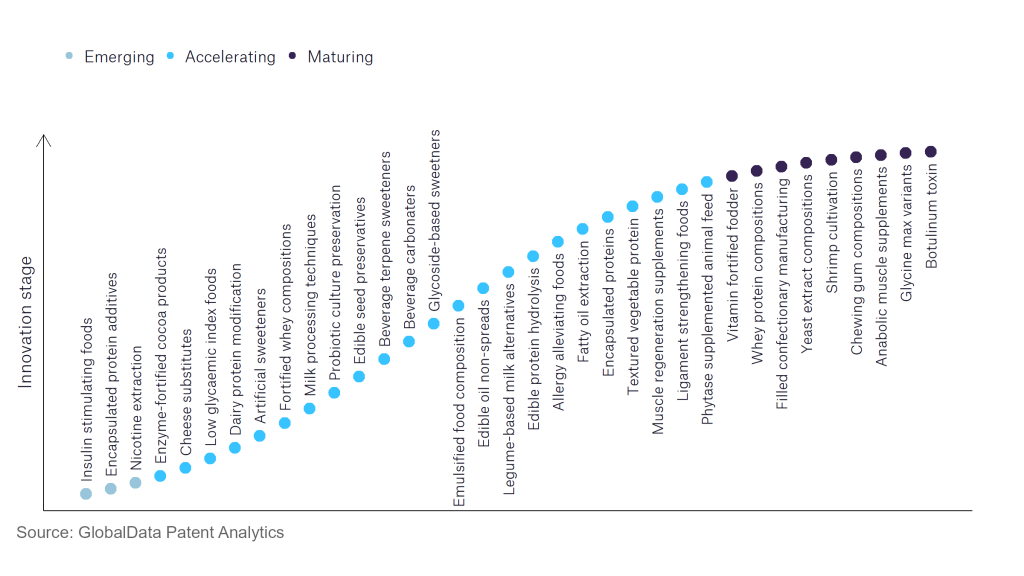The consumer industry continues to be a hotbed of innovation, with activity driven by convenience, health and wellness, aesthetics, and the growing importance of advanced computerised technologies, traceability enablers, and 3D food printer. In the last three years alone, there have been over 450,000 patents filed and granted in the consumer industry, according to GlobalData’s report on Innovation in Consumer: Edible protein hydrolysis. Buy the report here.
However, not all innovations are equal and nor do they follow a constant upward trend. Instead, their evolution takes the form of an S-shaped curve that reflects their typical lifecycle from early emergence to accelerating adoption, before finally stabilising and reaching maturity.
Identifying where a particular innovation is on this journey, especially those that are in the emerging and accelerating stages, is essential for understanding their current level of adoption and the likely future trajectory and impact they will have.
40+ innovations will shape the consumer industry
According to GlobalData’s Technology Foresights, which plots the S-curve for the consumer industry using innovation intensity models built on over 110,000 patents, there are 40+ innovation areas that will shape the future of the industry.
Within the emerging innovation stage, hydrogel dressings, dextrin-based compositions, and safety injection needles are disruptive technologies that are in the early stages of application and should be tracked closely. Emulsified food composition, edible oil non spreads and allergy alleviating foods are some of the accelerating innovation areas, where adoption has been steadily increasing. Among maturing innovation areas are shrimp cultivation and anabolic muscle supplements, which are now well established in the industry.
Innovation S-curve for the consumer industry

Edible protein hydrolysis is a key innovation area in consumer
In protein hydrolysis, peptide bonds are broken down to increase the free amino acid and carboxyl groups resulting in the hydrolysate becoming more soluble and digestible.
GlobalData’s analysis also uncovers the companies at the forefront of each innovation area and assesses the potential reach and impact of their patenting activity across different applications and geographies. According to GlobalData, there are 10+ companies, spanning technology vendors, established consumer companies, and up-and-coming start-ups engaged in the development and application of edible protein hydrolysis.
Key players in edible protein hydrolysis – a disruptive innovation in the consumer industry
‘Application diversity’ measures the number of different applications identified for each relevant patent and broadly splits companies into either ‘niche’ or ‘diversified’ innovators.
‘Geographic reach’ refers to the number of different countries each relevant patent is registered in and reflects the breadth of geographic application intended, ranging from ‘global’ to ‘local’.
Patent volumes related to edible protein hydrolysis
| Company | Total patents (2021 - 2023) | Premium intelligence on the world's largest companies |
| Impossible Foods | 57 | Unlock Company Profile |
| Cargill | 45 | Unlock Company Profile |
| Symrise | 32 | Unlock Company Profile |
| Parabel Nutrition | 23 | Unlock Company Profile |
| Ynsect | 22 | Unlock Company Profile |
| Roquette Freres | 20 | Unlock Company Profile |
| MycoTechnology | 19 | Unlock Company Profile |
| Parabel | 19 | Unlock Company Profile |
| Protix Biosystems | 17 | Unlock Company Profile |
| Burcon NutraScience | 15 | Unlock Company Profile |
| INGREDIA | 12 | Unlock Company Profile |
| Ripple Foods PBC | 11 | Unlock Company Profile |
| Nestle | 11 | Unlock Company Profile |
| OTC | 10 | Unlock Company Profile |
| J. R. Simplot | 8 | Unlock Company Profile |
| Napiferyn Biotech Sp Z OO | 7 | Unlock Company Profile |
| BRF | 7 | Unlock Company Profile |
| L’Institut National Recherche Agronomique | 5 | Unlock Company Profile |
Source: GlobalData Patent Analytics
Impossible Foods is one of the leading patent filers in edible protein hydrolysis along with Cargill, Symrise, and Parabel Nutrition. Recently, Cargill began construction to expand its production plant in Port Klang, Malaysia, for enlarging its portfolio in specialty fats. Cargill will install dry palm fractionation capacity, enabling the production of a range of specialty fats for use in chocolates, coatings, fillings and compounds, spreads, bakery fats, and other applications.
In terms of application diversity, Protix Biosystems leads the pack, with J. R. Simplot and Ripple Foods in the second and third positions, respectively. By means of geographic reach, INGREDIA holds the top position followed by Impossible Foods and Burcon NutraScience.
Edible protein hydrolysis will potentially become the approach favoured by many future food players, primarily due to its versatility and functionality. Through protein hydrolysis, leading companies will be able to provide tailored solutions aligned with customers’ needs.
To further understand the key themes and technologies disrupting the consumer industry, access GlobalData’s latest thematic research report on Consumer.
Data Insights
From

The gold standard of business intelligence.
Blending expert knowledge with cutting-edge technology, GlobalData’s unrivalled proprietary data will enable you to decode what’s happening in your market. You can make better informed decisions and gain a future-proof advantage over your competitors.



